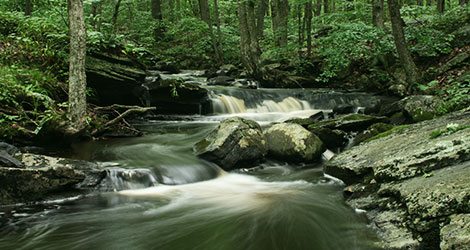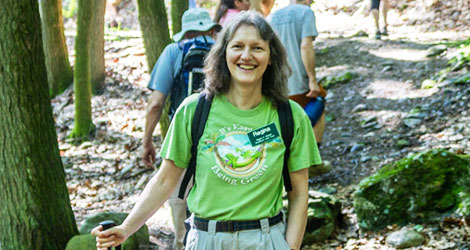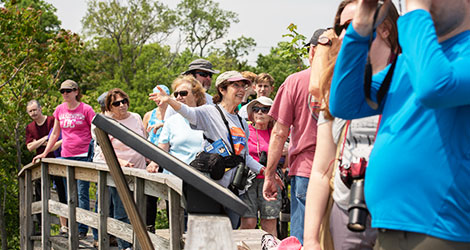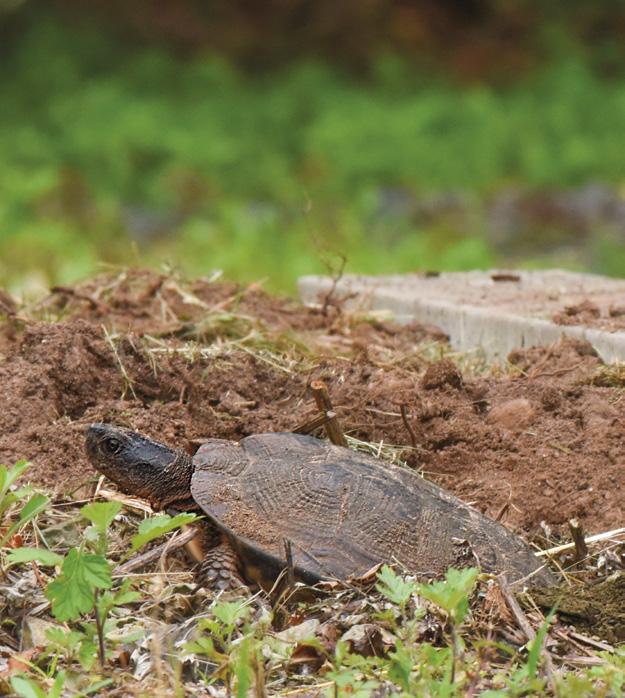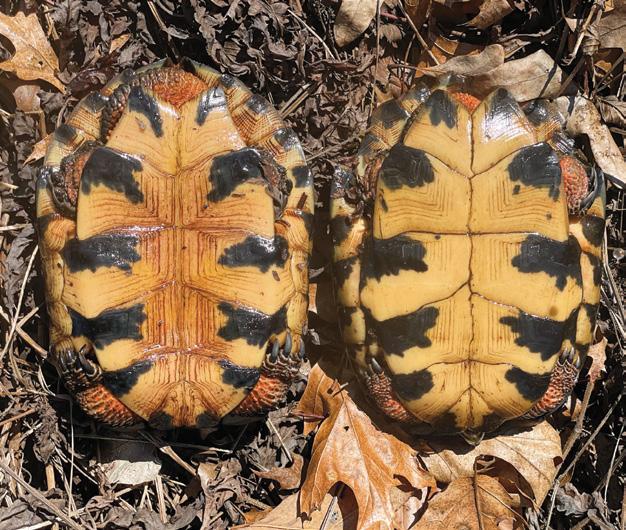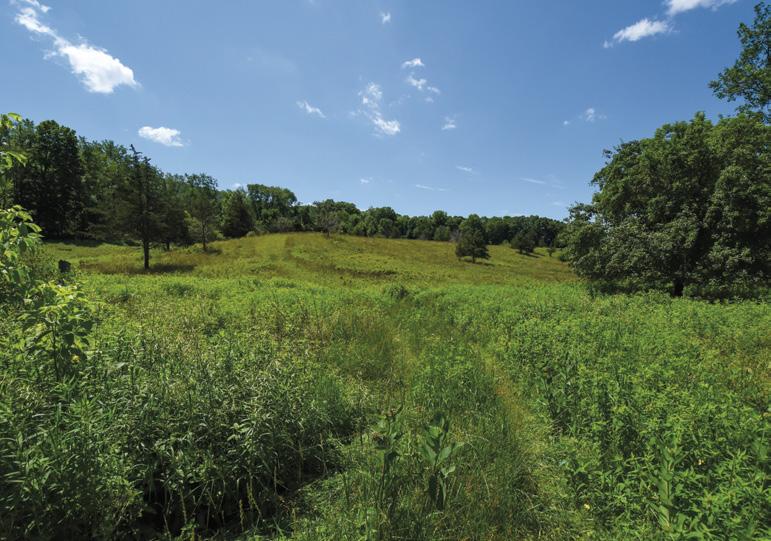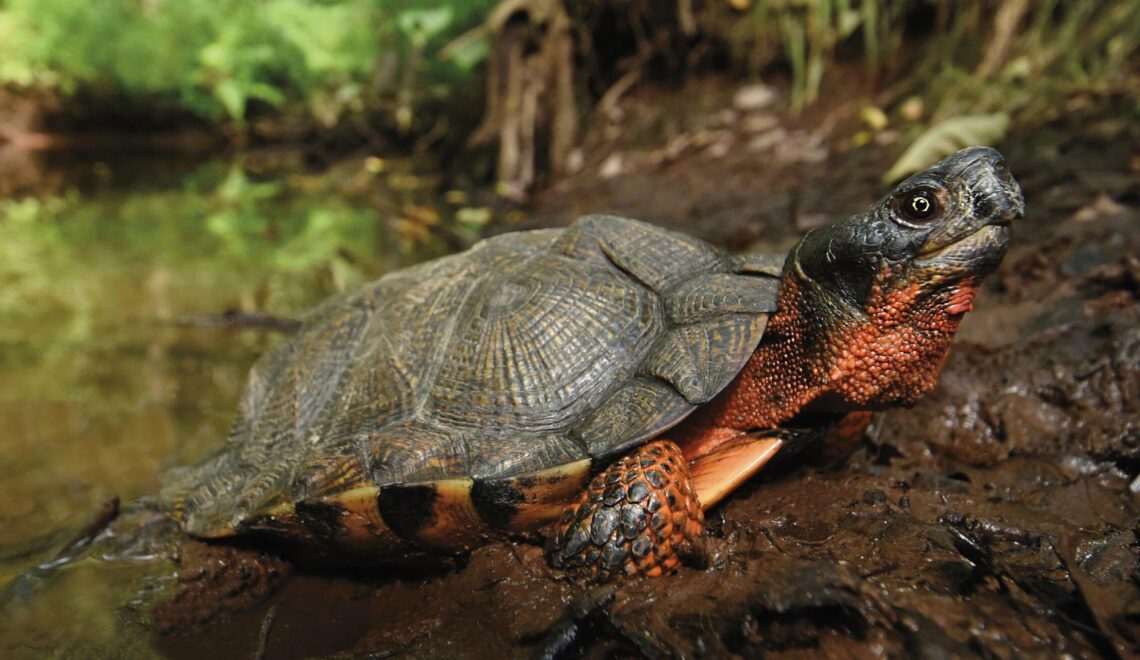
Turtle Tracks
Watching Out for Connecticut’s Wood Turtles
By Laurie D. Morrissey * Photos by Dennis Quinn
One sunny day in late winter, Dennis Quinn will get the urge to don a wetsuit and snorkel gear and jump into an ice-cold stream. There might be patches of snow on the ground. The air temperature will be in the upper 30s, the water temperature around 35. He’ll be looking for a quirky turtle that doesn’t spend the winter buried in mud at the bottom of a frozen lake or pond, but instead lazes about at the edge of a flowing river or mid-sized stream. He will reach into a tangle of roots and leaf litter and lift out a sleepy eight-inch wood turtle. Then he will set about taking measurements and using a small file to make a notch in the edge of the turtle’s shell.

Wood turtles enter a clean, fast-flowing stream in October and tuck up against an undercut bank, usually in a root tangle, log jam, or deep pool.
The wood turtle is a medium-sized turtle with a carapace that looks like it was crafted in an artist’s studio. Its scientific name, Glyptemys insculpta, refers to the sculpted appearance of its scutes, the segments of its top shell. Each scute has faint yellow growth rings radiating from its center, created by tannins and minerals that accumulate in the grooves. Orange, red, and pale-yellow pigments color the turtle’s throat and the undersides of its legs, contrasting with its dark brown or black shell.
Quinn, a consulting herpetologist for the Connecticut Department of Energy and Environmental Protection, is among the biologists monitoring wood turtles, which have become increasingly rare. Turtles are on the decline here and elsewhere, due in large part to urbanization. Of the state’s 12 native species—including sea turtles—nine are endangered, threatened, or of special concern. The state’s rarest is the tiny bog turtle, which has been on the federally endangered list since 1997.
Along with the box turtle, spotted turtle, and diamondback terrapin (a brackish water species), the wood turtle is a state species of special concern.
“The wood turtle population is not as stable as it once was,” Quinn says. “There are still plenty of streams that have them, but we worry about their sustainability in the long term. No streams in Connecticut harbor the number we would have seen historically.” He cites the Mill River in Hamden: “It used to be a big wood turtle spot. Now, they’re all gone.”
“The wood turtle population is not as stable as it once was. There are still plenty of streams that have them, but we worry about their sustainability in the long term. No streams in Connecticut harbor the number we would have seen historically.”
Dennis Quinn
Urbanization is the greatest threat. The wood turtle’s linear habitat consists of a river corridor and adjacent wetlands, woods, and fields, usually within 1,000 feet of the water. It spends the early spring, fall, and winter in its aquatic habitat, moving upland in summer. When development fragments their habitat, wood turtles are isolated from one another and cannot complete their life cycle.
Besides habitat loss and fragmentation, road mortality is a serious threat. When they leave the water to forage for food or search for mates, or to dig their nests in sandy soil, turtles are hit by cars and agricultural vehicles. Females may spend several days testing out sites, crossing roads in the process.
The other big threat is illegal collection, incidental and deliberate for the international black market. Even innocent collection can be harmful. Many people can’t resist the urge to bring a turtle home, at least for a while. Even if they return it to the wild, they may not return it to the location where it was found, and the turtle may lack the habitat it needs to survive.
Ironically, Quinn points out, public access to greenways in wetlands presents a threat to some wildlife populations by bringing paved paths, people, dogs, and the introduction of non-native species. “The impact of a path goes much further than those 10 feet,” he says. “It goes hundreds of feet beyond that.”
It is the turtle’s life history that makes it so vulnerable to depletion. “The removal of a single adult can significantly affect a population,” explains Hank Gruner, a Connecticut herpetologist with more than 30 years’ experience. “Their whole evolutionary strategy is to live a long time and reproduce. It takes wood turtles more than a decade to reach sexual maturity, after which they lay up to 12 eggs every year, to an age of as much as 75.”
A small percentage of those offspring survive, however, as eggs and hatchlings are preyed on by everything from ravens to hungry fish. Gruner contrasts these survival challenges with those of a garter snake: “They reach maturity in two years, skip the egg stage, and have 20 to 40 live babies. Even with a lot of road kill, they make up for it with successful reproduction.”
“The removal of a single adult can significantly affect a population”
Hank Gruner
When the weather gets cold, turtles begin hibernation. In cold-blooded animals, hibernation is called brumation, a period during which their body temperature, activity, heartbeat, and respiration drop but they still occasionally move about.
Wood turtles enter a clean, fast-flowing stream in October and tuck up against an undercut bank where the flow is lower, usually in a root tangle, log jam, or deep pool. They survive in open water just above freezing thanks to an evolutionary adaptation called cloacal respiration. Unlike snappers and painted turtles, which winter safely in mud under the ice, wood turtles need constant access to oxygen during brumation. Because their winter metabolism is so low—roughly five percent of what it is in summer—they extract enough oxygen for their needs from the water, mainly through the cloaca, the opening at the end of the digestive system. Biologists, especially when addressing groups of schoolchildren, often use the term “butt breathing.”
This process only works if there is enough oxygen in the water, Quinn says, which is why protection of healthy buffers along rivers is so critical to turtle conservation efforts. One example of human-caused danger is a winter gravel operation that changes the water level, exposing hibernating wood turtles and causing them to freeze.
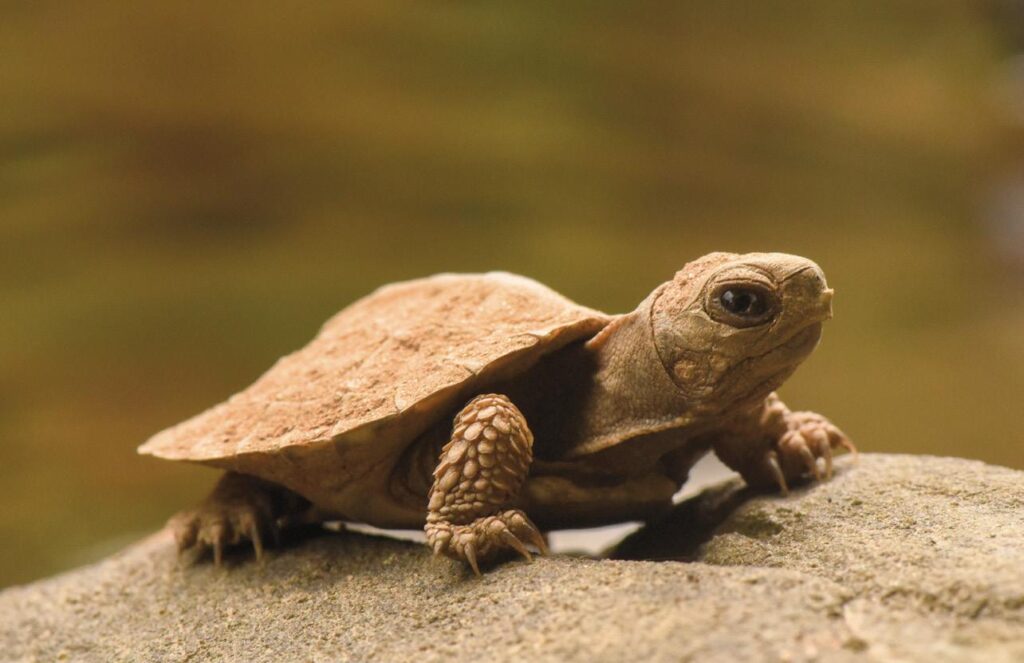
A hatchling wood turtle faces many challenges, from predators to vehicles to urbanization. Only a small percentage of wood turtles survive to adulthood.
If you ask a biologist exactly where to find wood turtles, you probably won’t get a straight answer. They are more comfortable telling you where you aren’t likely to find them. This way, they can highlight the species’ special habitat needs, and ways to ensure that those areas are protected. So don’t ask—just be glad when you find one. It’s a red-letter turtle day.
Laurie D. Morrissey is a New Hampshire-based writer of articles, essays, and poetry. Her work has appeared in Connecticut Woodlands since 2016, when she wrote about her father, Connecticut state park ranger Bill Dougal. Her writing has appeared in Northern Woodlands, Art New England, New Hampshire Home, Appalachia, and numerous poetry journals.

